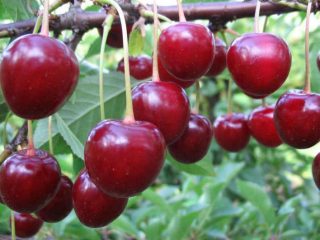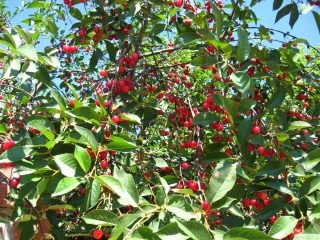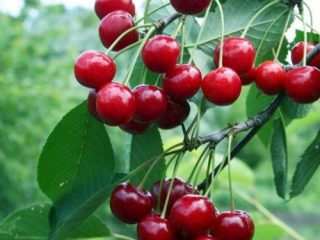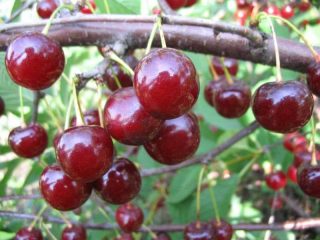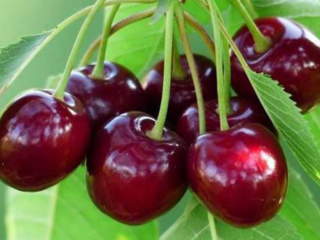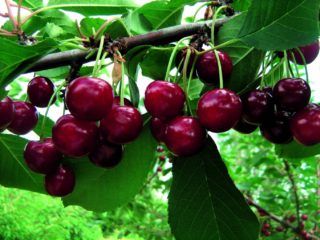Content
The culture was obtained in the process of crossing the varieties: Black large and Rossosh black. Cherry Khutoryanka was included in the State Register relatively recently - in 2004. Despite its many advantages, the variety has not become widespread.
Description of cherries Khutoryanka
It is a short tree with a spreading crown that forms in the form of a pyramid, cone or broom. Foliage densely covers every branch and shoot.
Leaves are oval with a pointed end, dentate at the edges, slightly wrinkled and pubescent. The color of the upper surface of the leaf is dark green, the lower part is light gray. Leaf sizes: length up to 10 cm, width up to 6 cm.
The petiole is thick, grows up to 2.5 cm, has a dark, burgundy shade.
The bark is brown with a gray or purple tint. Its surface is smooth, glossy or slightly rough. Old cherries may have flaky bark.
The branches grow to the trunk at an acute angle, and may break off during harvesting. Shoots are thickened, even and straight.
Height and dimensions of an adult tree
An adult Khutoryanka cherry tree has a height of no more than 4 m. The culture is classified as medium-sized. The crown does not exceed 5 m in diameter.
Description of fruits
Depending on the region, fruits ripen at the beginning or at the end of June. An average berry weighs 4 g and a diameter of 2 cm.
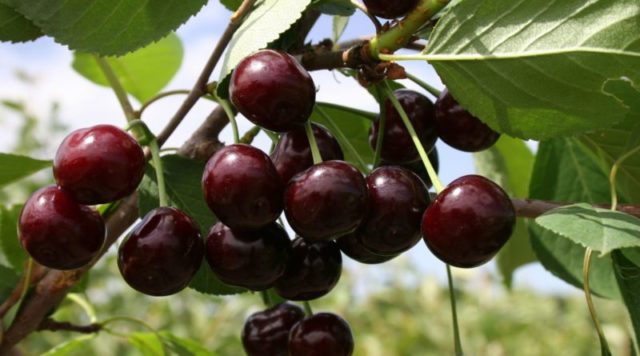
The shape of cherries can be round, flat round, heart-shaped, the color of the berries is dark red, almost black
The pulp is also dark red, juicy, firm. The drupe is light brown, covered with a thin layer of pulp, from which it is difficult to separate. The separation of the cherry from the stalk is dry.
In the process of ripening, the berries are not baked in the sun, the shedding is weak.
Khutoryanka cherries are sweet, with a slight sourness and astringency. The tasting score is 4.5 points.
Pollinators for cherries Khutoryanka
It is self-fertile and does not require pollinators. The absence of related crops in the garden does not affect the yield. This greatly facilitates maintenance.
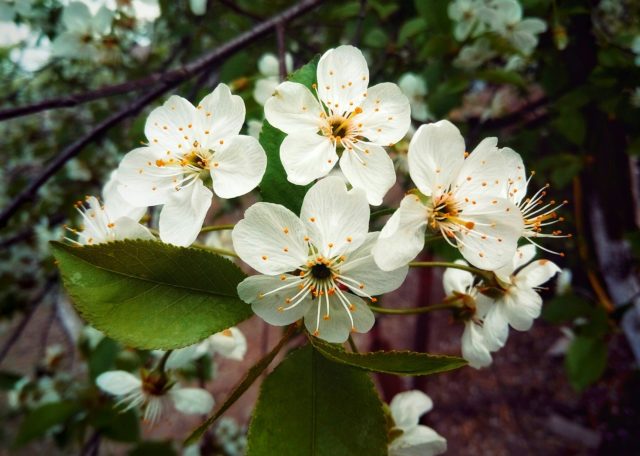
Cherry Khutoryanka blooms in late May, small white buds form large fragrant inflorescences
Main characteristics
Cherry Khutoryanka belongs to medium-yielding, unpretentious varieties. The technological and consumer qualities of the berries are high.
Drought resistance, frost resistance
In hot dry summers it is recommended to water Khutoryanka cherries once a week. Do this in the evening, after sunset, always with warm water. If there is enough rainfall, the tree does not need watering.
The farmer's cherry is resistant to frost. Only young seedlings of the first year need shelter.
Adult plants recover easily from frost damage. The main feature of the variety is the ability to adapt to difficult climatic conditions.
Yield
The Khutoryanka cherry fruits ripen in early or late June. After planting, the culture bears fruit for 3 or 4 years. The first season will be the most lean, the number of fruits harvested will not exceed 2 kg. 5 years after planting, they begin to collect the long-awaited, bountiful harvest, which will amount to about 10-12 kg of berries from one tree.
If you carry out timely pruning of the thickened crown, top dressing and watering in dry summer, the yield of the tree can be increased to 20 kg.
The high density of the pulp allows you to store the berries for 1.5 weeks and transport them over long distances without losing marketability.
Cherry Khutoryanka is eaten fresh and used for processing. Juicy pulp gives a lot of dark, thick juice. Cherries are good in compotes, jams, preserves.
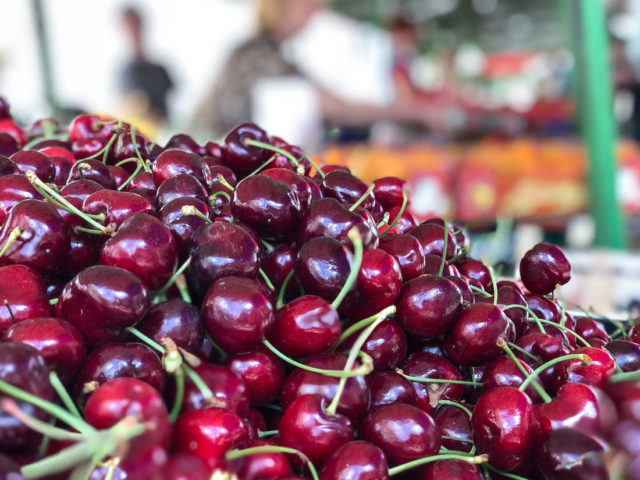
Due to its dense pulp and the ability to tolerate transportation, the Khutoryanka variety can often be found in the markets as a dessert
Advantages and disadvantages
Despite the large number of positive qualities, Khutoryanka cherry has a number of disadvantages. These include low productivity, average ripening times, branches that easily break off from the trunk.
Advantages of the variety:
- good taste of berries;
- transportability;
- high keeping quality of fruits;
- adaptability to a difficult climate;
- high technical qualities;
- quick recovery of the tree after damage.
Also, the Khutoryanka variety is slightly affected by moniliosis - fruit rot.
Landing rules
A selectively bred variety needs proper planting and care. Subject to all the rules, the cherry will bear fruit in accordance with the varietal characteristics, within 14-15 years.
Recommended timing
For the southern regions, experts recommend planting Khutoryanka cherries in a warm autumn - at the end of September.
In the central and northern regions, fruit trees are planted in the spring, after the soil warms up well. This is the beginning or end of May. It is important to wait for dry, warm and calm weather.
Site selection and soil preparation
For planting cherries, Khutoryanka choose a well-lit part of the garden on the south side.
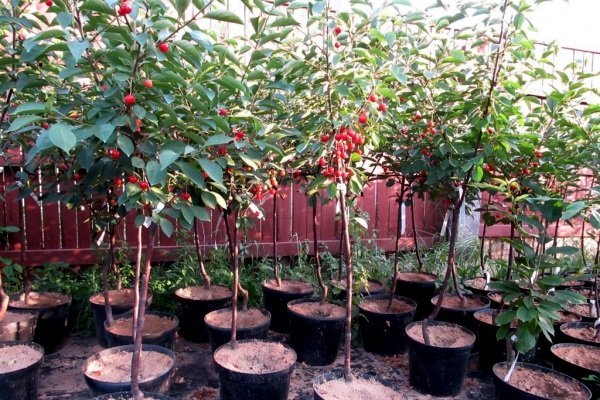
The tree on one side must be protected by a building or fenced off from the north wind
Also, the buildings will shade the seedling from the scorching sun at noon.
Groundwater should be no closer than 2.5 m to the surface of the earth. Low-lying areas where there is a possibility of stagnant rain or melt water should be avoided.
The soil should be loose, fertile, sandy loam or loamy. Acidified soils are not suitable for growing the Khutoryanka variety. 2 weeks before planting, the soil is fertilized by introducing complex mineral fertilizers. Immediately before planting, the top layer of the earth is mixed with wood ash, potassium chloride or humus.
How to plant correctly
When laying a cherry orchard, indents of 4 m are made between the rows, and between the seedlings - 3 m. It should be taken into account how much the crown will spread during the growth of the tree.
Before planting, the rhizome of the seedling is checked: damaged and rotten shoots are removed. If the root is dry, it is soaked in warm water with a weak solution of manure for an hour.
Landing Algorithm:
- Dig a hole 80 cm in diameter and 0.5 m deep.
- Install a peg in the center of the recess, fix it.
- Place the seedling near the stake, straighten the root shoots. It is important to ensure that the root collar rises 3 cm above the soil level.
- The root is covered with earth, the trunk of the seedling is tied to a peg.
- The soil is slightly tamped, a near-stem hole is formed.
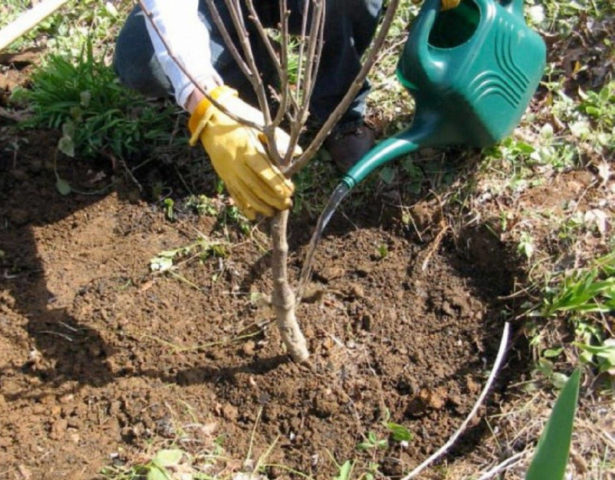
After planting, the seedling is watered with 2 buckets of warm water, at the last stage the trunk circle is mulched
Care features
Proper grooming is just as important as landing. Cherry variety Khutoryanka is unpretentious, does not need special care.
Watering and feeding schedule
For the first 2 years, the Khutoryanka cherry needs abundant and frequent watering in the warm season. On average, it is 2 times a month. The water is slightly warmed up before watering, it is poured only within the radius of the trunk circle.
Top dressing is carried out at the 2nd year of a young tree's life. To do this, use special mineral complexes for fruit trees or rotted manure diluted in water 1:10.
Pruning
The first pruning is done immediately after planting. The second procedure is carried out in the fall - damaged and rotten shoots are cut off.
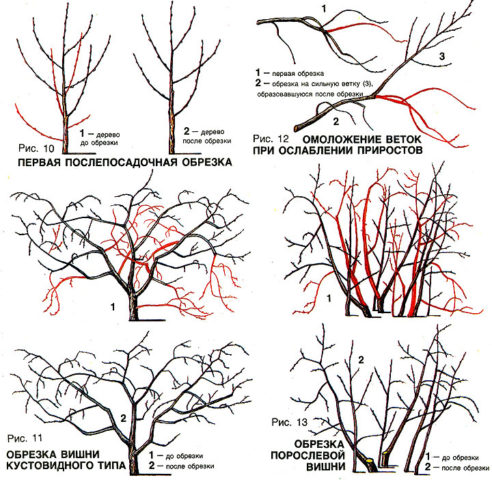
Mature trees are pruned in spring and fall
In the process, the crown is formed and thinned, unnecessary diseased or infected branches are removed.
Preparing for winter
Cherry Khutoryanka belongs to winter-hardy varieties, it should not be wrapped up for the winter. If the tree was planted in the fall in the central or northern region, then in the first year it should be insulated.
In the fall, after harvesting, the crown of the Khutoryanka cherry is thinned out, the ground in the area of the trunk circle is loosened, watered, and then mulched.
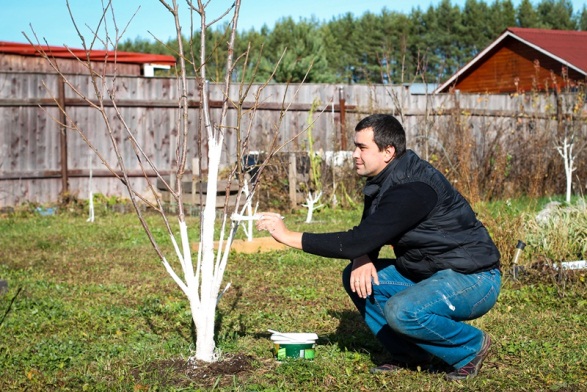
The tree trunk is whitewashed to protect it from rodents
Diseases and pests
Cherry Khutoryanka is not resistant to coccomycosis, a fungal disease that affects the leaves of hearth trees. At the initial signs of the disease, the culture is treated with fungicides. The first time the procedure is carried out in the spring after flowering, then in the fall, after harvesting.
Cherry Khutoryanka can be attacked by leaf rollers, aphids, moths. If the larvae of these insects appear on the foliage of the tree, they are treated with chemicals or special sticky traps are installed.
Conclusion
Cherry Khutoryanka is an unpretentious variety of Russian selection. It is intended for planting in the central and northern regions. Cherry is distinguished by its high frost resistance and adaptability to harsh climatic conditions. The fruits of the Khutoryanka variety are suitable for fresh consumption and for processing, they are well stored, they are transported over long distances without losing marketability.

